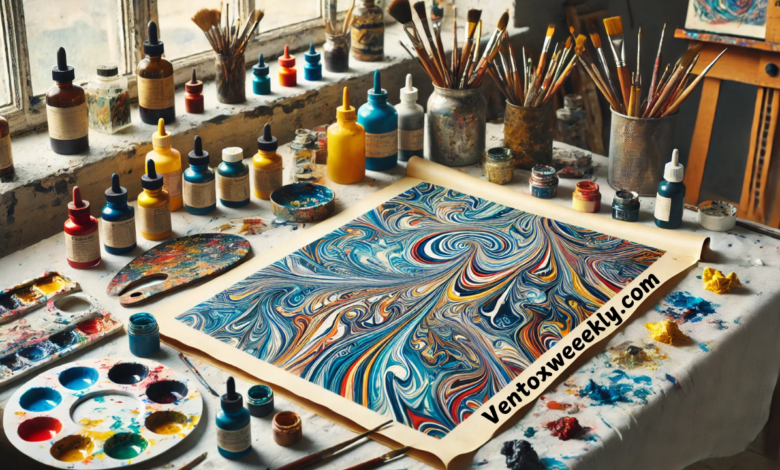Does Acrylic Stick to Tyvek Marbling? An In-Depth Exploration

Marbling with acrylics on non-traditional surfaces like Tyvek has intrigued artists and crafters looking to expand their creative horizons. Tyvek, a durable and versatile material, poses unique challenges and opportunities for marbling. This article delves into whether acrylic paint adheres well to Tyvek when used in marbling techniques, covering the necessary preparations, suitable acrylic types, and practical tips to ensure success.
Understanding Tyvek and Its Characteristics
Tyvek, manufactured by DuPont, is a synthetic material made from high-density polyethylene fibers. Renowned for its resistance to water, tearing, and mildew, Tyvek is commonly used in protective apparel, envelopes, and as a house. In the art world, its unique texture and durability make it an appealing choice for experimental and mixed-media art projects.
Challenges of Acrylic Marbling on Tyvek
Acrylic paints are celebrated for their versatility and vibrant colors, but they are typically formulated for porous materials such as canvas and paper. Tyvek’s non-porous nature presents challenges:
- Adhesion Issues: Tyvek’s smooth surface can inhibit the acrylic paint’s adhesion, leading to peeling or flaking.
- Absorption Differences: Unlike more absorbent materials, Tyvek does not soak up paint, affecting the drying and curing process.
Preparing Tyvek for Acrylic Marbling
Adequate preparation can significantly enhance the adhesion of acrylic paints to Tyvek:
- Surface Sanding: Lightly sanding the Tyvek can create a texture more conducive to paint adherence.
- Cleaning: Any oils or residues on Tyvek should be removed to prevent interference with paint application.
- Priming: Applying a primer designed for non-porous surfaces can provide a better base for the acrylics.
Selecting the Right Acrylic Paints
Not all acrylic paints are equal in their ability to stick to non-traditional surfaces like Tyvek. For successful marbling:
- Specialized Acrylics: Opt for acrylics specifically formulated for use on non-porous surfaces. These often contain additives that improve adherence.
- Viscosity and Texture: Thicker, heavier body acrylics may adhere better than fluid acrylics, prone to sliding off slick surfaces.
Marbling Technique Adaptations
Marbling involves floating paints on a liquid surface and transferring patterns onto an absorbent material. Adapting this technique for Tyvek involves several adjustments:
- Marbling Medium: Use a marbling medium or a thickener to help the paint float and improve transfer to Tyvek.
- Water-to-Paint Ratio: Ensuring the correct balance can prevent the paint from becoming too diluted, which is crucial for non-porous surfaces.
- Dipping and Curing: Good adhesion requires carefully placing Tyvek on the paint surface and allowing ample drying time.
Tips for Successful Acrylic Marbling on Tyvek
To maximize the prospects of success, consider the following tips:
- Test Samples: Always experiment on small pieces of Tyvek before starting a full-scale project.
- Layering Techniques: Applying multiple thin layers of paint may help build up a more robust color and adhesion.
- Sealing the Artwork: Once the marbled Tyvek is dry, sealing it with a clear acrylic spray can protect and enhance the artwork.
Comparative Analysis: Tyvek vs. Other Surfaces
Comparing Tyvek to more traditional marbling substrates highlights its unique properties:
- Porous Surfaces: Paper and fabric, being more absorbent, generally allow for more effortless paint transfer and adhesion.
- Non-Porous Alternatives: Like Tyvek, materials such as Mylar and certain plastics require specific preparation and paint formulas for effective marbling.
Conclusion
Marbling with acrylics on Tyvek is feasible and a gateway to innovative artistic expressions. While it requires specific preparations and techniques, the results can be gratifying, offering artists a durable and distinctive medium for their creative ventures. Experimentation and adaptation are essential, as each project on Tyvek may reveal new insights and possibilities in the fascinating world of acrylic marbling.
FAQs: Does Acrylic Stick to Tyvek Marbling
What is Tyvek, and why is it used in marbling?
Tyvek is a synthetic material manufactured from high-density polyethylene fibers. It is known for its durability, water resistance, and abrasion resistance. It’s used in marbling for its unique texture and ability to hold up under wet conditions, making it ideal for creating long-lasting artistic projects.
Does acrylic paint stick to Tyvek?
Yes, acrylic paint can stick to Tyvek, but its non-porous nature requires specific preparation and techniques. Using a primer, selecting suitable acrylic paints, and adequately preparing the surface can improve adhesion.
How should I prepare Tyvek for marbling with acrylics?
Prepare Tyvek by lightly sanding the surface to generate a texture for the paint to adhere to, cleaning it to remove any residues, and applying a primer suitable for synthetic surfaces.
What type of acrylic paint works best for Tyvek marbling?
Acrylic paints formulated for non-porous surfaces or those containing additives to improve adhesion on slick surfaces are best. Thicker, heavier body acrylics may also adhere better than more fluid types.
Can I use any primer on Tyvek?
Using a primer designed for synthetic materials or non-porous surfaces is best. These primers create a textured layer that helps acrylic paint adhere better.



